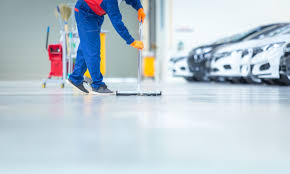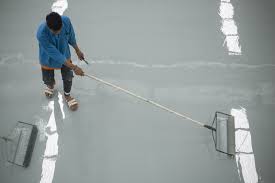How do you maintain an epoxy floor?
Maintenance guide for epoxy floors, caring for the epoxy floor.
Epoxy floors are a tough, resilient and very durable type of floor coating used in multiple applications; garage floors, sunroom floors, high traffic hallways and walkways or warehouses. Areas, where machinery and other large tools are being used, a durable epoxy surface makes a great choice for a flooring surface. Even when these heavy objects are being shifted around on the floor continuously, the epoxy floor surface will maintain a very high luster. Epoxy floors are pretty easy to maintain as long as you follow some ground rules.
How to care for your epoxy floors.
You will want to provide at least minimal maintenance for an epoxy floor to keep it in top shape. Even though they are low maintenance, common sense should prevail in caring for them. In this blog, we have listed the best practices in caring for your epoxy floors.
Keep the surfaces dirt and grit free.
Especially if you are moving machinery or vehicles on and off the floor. Dirt and grit will embed or scratch an epoxy floor if allowed to remain there. It’s a good idea if you remove all sand or dirt on a regular basis because even though Epoxy floors are tough they can start to show the damage from multiple scratches over time. Best way to do that is to use a shop vacuum with a soft brush attachment. How often you vacuum depends on how much dirt and grit are tracked onto the floor. When it comes time to move heavy machinery across the floor, take extra precautions to ensure the surface is dust and grit free.
Avoid using soap-based cleaners.
Soap-based floor cleaners leave a haze on the epoxy flooring that builds up over time. Epoxy floors do not need soap, warm water, and a good mop or deck-scrubbing brush should be just fine. If you need extra scrubbing power use something like soft soap to aid you with the tougher spills.
Spot Cleaning.
Often you only need to vacuum or sweep a small area of the floor where something has been spilled or tracked in. The liquid that has been spilled needs to be vacuumed up along with any dirt and grime with a shop vac and then clean the area with a mop and warm water. Epoxy floors are highly water resistant and very easy to clean when liquid spills occur.
Heavily soiled epoxy floors.
The best way to clean up a dirty epoxy floor is as follows: Sweep and vacuum the entire area carefully. Remove all items in the way to get to the floor. Once you have removed all the surface dirt, grime, and grit, use a hard foam mop and warm/hot water to get rid of all the built-up dirt. After that, you can use a clear ammonia/water mix (at 2-3 ounces ammonia per gallon of hot water) for second mopping.
Stains
Some stains, such as rust, need to be lightly scrubbed with a kitchen scrubbing sponge or a soft deck brush and warm water. Avoid using steel wool or harsh chemicals like comet, they are too abrasive. Use soft-scrub and a moderately abrasive scrubbing pad or brush. Don’t ever use any cleaning compounds with citrus or acid in them. Citrus cleaners and vinegar will break down the epoxy catalyst and must be avoided.
Oil, car chemicals and other chemicals.
Wiped up antifreeze, oil and other car-related chemicals with shop towels or a paper towel and dispose of properly. The important thing about car spills is to not allow them to sit on the floor surface for too long. Even engine oil has chemicals that could be potentially hazardous to an epoxy floor. Clean up spilled gas immediately, because it will damage the surface of an epoxy floor if allowed to sit for too long. Paint, household cleaners and other abrasive liquids need to be cleaned up immediately. To clean, wipe them up with shop towels as soon as the spill occurs.

How to Clean Epoxy Floors
Epoxy floors are not hard to maintain. In fact, many people choose epoxy floors for their garages because they are so easy to care for. However, there are some guidelines for keeping your epoxy floors clean. By performing general maintenance, doing a deep cleaning every few months, and removing stains as needed, you can keep your epoxy floors in excellent shape.
Performing General Maintenance
Dust mop once a week. The best way to maintain your epoxy floor is to run a soft dust mop over it once a week. This removes dirt and dust gently, which prevents scratches and protects your floor.[1]
For floors with an anti-slip aggregate coating–such as aluminum oxide–a soft bristle push broom may be more effective than a standard dust mop.
Vacuum any joints once a month. If you have visible construction joints or saw cuts, you should use a vacuum to clean these out. For best results, use your vacuum attachment hose with a crevice tool. Vacuum these joints about once per month.
If you do not have a vacuum, you can try to clean any joints/cuts with a stiff bristle broom.

Durability & Life
Depending on the level of traffic and usage, most floors will require the occasional touch-up or recoat. However, appropriate care and upkeep will ensure your polymer flooring will last a long time. A simple, quick routine of easy maintenance can keep your no-wax, high performance floor looking showplace-new for years, saving you time and money in the long run. General Tips for Caring for Your Floor Every floor is different and requires adequate care in order to preserve its appearance, performance and life. Your professional polymer flooring installer can offer the correct method and procedures to maintain your particular flooring system. However, here are general tips on caring for your floors:
Sweep Your Floors Daily
Use a soft-bristled broom or mechanized sweeper to sweep your floors daily. This will remove any foreign objects and prevent safety hazards. Additionally, daily sweeping helps extend the life of your floor.
Wash Your Floors Weekly
Generally, weekly mopping of your floors will be sufficient to keep your floors performing and looking great. High-traffic and heavy-duty areas may require additional attention. Use a soft bristled mechanized floor scrubber if needed.
Clean Spills Immediately
Not only do spills present a potential safety hazard, they can be damaging to your floor depending on the substance and nature of the liquid spilled. Depending on the chemical resistance of your flooring, acids, caustics and harsh solvents can damage your floor coating and should be cleaned immediately.

How to Take Care of Indoor Epoxy Floors
Epoxy floors, also called terrazzo, contain chips of marble or stone suspended in mortar bed. Older versions used cement mortar to suspend the marble chips, but more modern varieties use a durable, easy-to-maintain and lightweight epoxy resin. Epoxy floors resist staining and scratches, making them an attractive and damage-resistant option for high-traffic areas within the home. With proper cleaning and care, an epoxy floor can last a lifetime or longer.
- Sweep the floor daily in high-traffic areas and at least once a week in lower-traffic areas of the home with a dust mop. Remove rugs and sweep beneath furniture to remove as much grit as possible. Although durable, grit on the floor can cause scratching and wear to the epoxy and stone surfaces.
- Mix a neutral nonalkaline, nonacidic floor cleaner or a cleaner specifically formulated for epoxy floors with hot water. Follow package recommendations for the amount of cleaner and water needed.
- Mop the floor with the cleaner at least once weekly. Kitchens and entryways may require more frequent mopping due to traffic and spills.
- Allow the cleaning solution to sit on the floor for approximately 5 minutes. Mop it up with clear water before the solution dries on the floor.
- Wipe the floor dry with a dry mop or large towel. Drying the floor prevents streaks and dust lines on the epoxy.
Tips for Preserving Your Epoxy Flooring
Epoxy flooring can be a great option for food and beverage flooring, healthcare flooring, and industrial flooring. This type of flooring has been used for decades — in fact, polymers have continuously been used on top of concrete for more than 35 years. With its slip-resistant and durable features, epoxy coating is a popular choice for those industries that need a long-lasting, reliable floor. While epoxy is durable, it’s not invincible. So after your flooring is installed by epoxy coating specialists, it’s important to perform routine maintenance in order to ensure your epoxy coating lasts as long as possible. With that being said, this article will give some tips and tricks for maintaining your epoxy flooring.
- Routine maintenance should be done with a soft bristle broom or commercial dust mop. In order to make sure your flooring remains free of debris, it’s best to sweep or mop daily.
- Heavy duty cleaning is best done after sweeping away any debris. You can use a hard foam mop, hot water, and clear ammonia. This mixture will remove any spills or stains that have made their way to the floor. Additionally, an epoxy floor can simply be hosed down and squeegeed dry.
- When choosing cleaning products, it’s important to remember not to use any products that contain acids or soap-based cleaners. These cleaning products can leave a residue on the flooring that can cause it to become slippery when wet.
- Staining may require light scrubbing with a scrubbing pad. Epoxy coating specialists do not recommend using abrasive cleaning chemicals on the flooring.
- To reduce damages caused by snow or water from shoes, welcome mats should be placed in front of any doors in the facility. Additionally, “pretreatment” winter compounds can leave a hazy film on the flooring. In order to remove this, hot water and a deck brush should be used and extra rinsing will keep the compounds from drying onto the floor.
- Heavy equipment may damage flooring over time when continuously dragged or placed in the same spot. Because of this, it’s important to ensure all areas are clean prior to lifting heavy loads with rolling jacks and remember to place pieces of plywood under jack stands when they’re holding heavy loads.